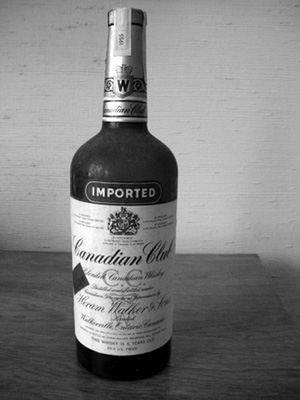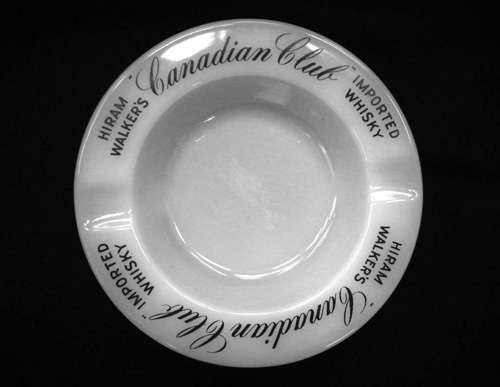Mad Men opens in a smoky bar, with Don Draper making notes on a napkin, an empty cocktail glass on the table. He’s jotting down ideas for promoting Lucky Strike cigarettes, one of Sterling Cooper’s most important clients. When the waiter asks if he’d like another drink, he replies, “Yeah, do this again. Old Fashioned, please.”
An Old Fashioned: it’s the very first food or beverage mentioned in Mad Men, and this popular cocktail makes many appearances in the series. It’s Don’s drink of choice. And Roger Sterling, with whom Don does a fair share of drinking? He’s a martini man.
The unidentified restaurant where Don and Roger get loaded and down dozens of oysters later in the first season could well be the Grand Central Oyster Bar (see Grand Central Oyster Bar’s Oysters Rockefeller), so we turned to this legendary Manhattan eatery for the recipes for these classic cocktails. The Oyster Bar still serves them in the classic 1960s style, too: the martinis are served in small martini glasses because, as manager Jonathan Young explained to us, the martini gets too warm in a larger glass. (The trend to larger martini glasses simply reflects Americans’ penchant for bigger is better.) And the Oyster Bar mixes an Old Fashioned just as Don does: they muddle (mash) the fruit.
At the country club where Roger and Jane Sterling are hosting a Kentucky Derby–themed garden party (season 3, episode 3; “My Old Kentucky Home”), Don meets a man named “Connie” looking in vain for bourbon behind an untended bar. (Unbeknownst to Don, Connie is Conrad Hilton, the hotelier.) As Don goes about making two Old Fashioneds, he asks Connie if rye is okay. But whether you prefer your Old Fashioned with bourbon or rye, to muddle or not to muddle, that is the question.
An Old Fashioned typically includes sugar (dissolved with a little water), bitters, bourbon or rye, a thin slice of orange, and a cherry. When the Drapers’ neighbors, Carlton and Francine Hanson, come over for cards one evening, daughter Sally makes the drinks. As she hands Don and Carlton their Old Fashioneds, Don has a little critique of Sally’s style. “Muddled,” he instructs. “That means smash it” (season 2, episode 2; “Flight 1”). And when Don makes Old Fashioneds for himself and Connie he muddles the fruit. Some think muddling the fruit imparts too much sweetness to the drink, but it’s obviously Don’s preferred method.
The earliest recipes for what would one day evolve into the Old Fashioned date to the early 1800s, and legend has it that the drink by that name first appeared at the Pendennis Club in Louisville, Kentucky, which explains why bourbon would have been the whiskey of choice. But when it comes to whiskey, Don’s preferred brand is Canadian Club. (Canadian Club uses the Scottish spelling, whisky, though the American usage is whiskey.)
There are many types of whiskey. Bourbon is a corn-based spirit distilled to no more than 160 proof (80% alcohol) and aged at least two years. Tennessee whiskey is similar, but is filtered through sugar maple and charcoal. Rye makes a lighter-flavored but full-bodied whiskey and is often blended with other whiskeys to make a final product. Such blended whiskeys are often simply called rye despite the additional ingredients. Canadian Club is such a blended whiskey, made of corn, rye, rye malt, and barley distillates. Almost all whiskeys are aged for years in charred wooden barrels to add flavor and are typically 80 to 100 proof.
There have been numerous variations in Old Fashioned recipes over the years, with much attention paid to how to dissolve the sugar: some say water, others seltzer, and still others the bitters. The first recipe calling for orange and cherry together, as part of the recipe and not simply a garnish, appeared in 1933, but various recipes have incorporated orange curaçao, pineapple, lemon peel, simple syrup (instead of sugar), and even absinthe.
There is no absolutely definitive Old Fashioned recipe, but we wanted to provide the Old Fashioned as Don liked it, with his “beloved rye,” as Roger once described it (season 1, episode 7; “Red in the Face”), and think the Grand Central Oyster Bar hit the oyster on the shell, so to speak, with this one.

A VINTAGE BOTTLE OF CANADIAN CLUB WHISKY, CIRCA 1960
COURTESY OF THE GRAND CENTRAL OYSTER BAR, NEW YORK, NEW YORK
NOTE: Bourbon or rye may be used in the Old Fashioned. Rye was originally used, and the Grand Central Oyster Bar is starting to use rye again in these drinks; they use Michter’s, but Don would likely choose Canadian Club, the brand we often see in his office and home. Seagrams V.O. and Crown Royal were also popular in the 1960s, says Jonathan Rogers of the Grand Central Oyster Bar.
1 orange slice
1 maraschino cherry
1 teaspoon sugar
Few drops of Angostura bitters
A splash of soda water to muddle ingredients
21⁄2 ounces rye or bourbon
YIELD: 1 DRINK
Unless you count the olives, a traditional martini only has two ingredients, gin and vermouth. There is some flexibility, however, as some have gin and both dry and sweet vermouth, while others include a pearl onion and/or a lemon twist. Flavored martinis, which a traditionalist such as Roger likely would have abhorred, have also appeared since the days of Mad Men: chocolate, pear, apple, and pomegranate, among them.
As with so many cocktails, the origins of the martini are, well, muddled. One legend has it that the martini originated in a Martinez, California, saloon in 1870; another says that a man named Martini di Arma di Taggia first mixed gin, vermouth, and orange bitters, chilled them on ice, and strained them into a chilled glass at New York’s Knickerbocker Hotel in 1911. But the name martini first appeared in the New and Improved Bartending Manual published in 1888, lending some credence to the first story and seeming to disprove the second.

A PERFECT ASHTRAY FOR THE DESK OF DON DRAPER
Arcane debates aside, our aim was to find a martini Roger would have savored. Since he and Don certainly seemed to be enjoying the drinks served with their oysters, it’s fitting that we’ve used the Grand Central Oyster Bar’s martini recipe, as well.
COURTESY OF THE GRAND CENTRAL OYSTER BAR, NEW YORK, NEW YORK
NOTE: Serve in a small martini glass and put leftovers in a rocks glass.
1⁄8 ounce dry vermouth
21⁄2 ounces gin
YIELD: 1 DRINK